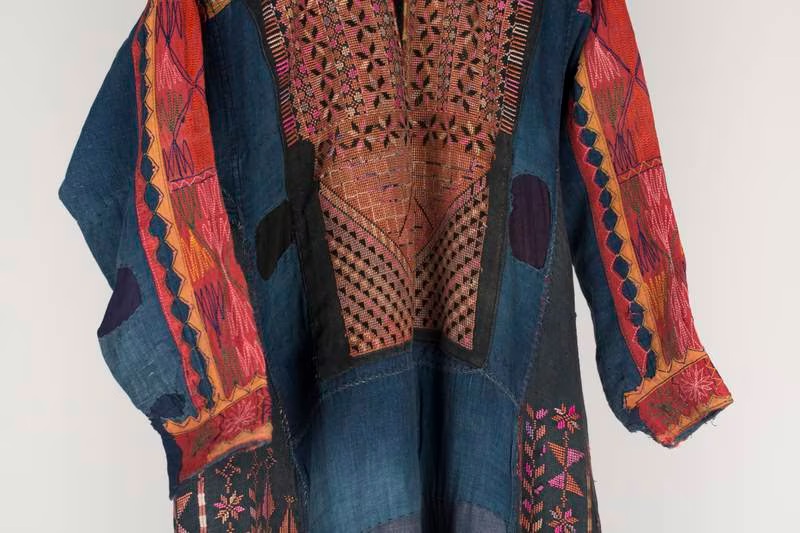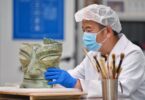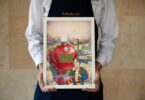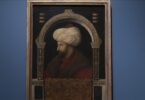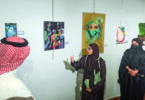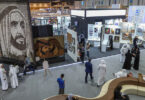Melissa Gronlund
“The thobe tells the story of a woman’s life,” says Rachel Dedman of her show of Palestinian embroidered dresses. “It was a way for a woman to show her social and economic status, her village and, ultimately, social realities.”
Material Power: Palestinian Embroidery is a display of more than 40 thobes, as well as contemporary works by artists including Mounira Al Solh, Khalil Rabah and Aya Haidar, and elements of popular culture in which embroidery appears to show the extraordinary creativity of these finely worked garments. The exhibition is on display at Kettle’s Yard in Cambridge in the UK until October 29.
Tatreez– added to Unesco’s Intangible Cultural Heritage list in 2021 – is a form of cross-stitch embroidery used by rural women in Palestine to embellish their dresses. Intricate patterns are worked on to the chest panel of a woman’s dress, known as the qabbeh, as well as the back or shinyar and sides, banayek.
Girls learnt to embroider from as young as six years old and would work towards their wedding trousseau, ornamenting their dresses with handed-down patterns inspired by the world around them: the palm tree motif, “old man’s teeth” (a jagged pattern), or the Al Haram tiles, drawn from the Dome of the Rock.
Once worn, the dresses were used over decades, changing with the women’s lives. When a woman had children, she would make cuts where the front panel joined the dress, so that she could more easily breastfeed. Others were let out or taken in as a woman’s shape changed or as it was passed down to others.
:quality(70)/cloudfront-eu-central-1.images.arcpublishing.com/thenational/XDB676UYX5FWTIYB7PWAQIQK5Q.jpg)
Thobes also told the story of Palestine, and in particular, as Dedman puts it, “the human reality of these big-picture events”.
The Cambridge exhibition opens with the Nakba thobe, a white dress, now discoloured in parts, with closely worked dark red embroidery. Its owner, Maha Abu Shoheh, says it is likely to have been one of the thobes Ramallah and Jerusalem residents donated to internally displaced people who fled the fighting in 1948. Two panels under the arms show how the person who wore it enlarged it.
“She didn’t have any textiles,” explains Abu Shoheh. “The only thing that she had was a sack from the flour that the refugees were given, so she used it to make the dress longer.”
The logo is still partially visible, as is the change in material.
“It symbolises how the people in Ramallah accepted refugees,” continues Abu Shoheh, who lives in the West Bank city with her family. “They shared houses; they gave them a place to live. They gave them food; they gave them their dresses.”
The patterns of embroidery – and even the shade of colours of the thread used – varied from village to village, serving as a marker of each person’s identity. Abu Shoheh’s collection began from her own search to find the thobe from her ancestral village, also called Abu Shoheh, which her family had had to leave.
“My grandmother used her best dress for everyday life – so it was totally worn out,” she says. “I kept asking her what our dress looks like, but I never saw it. I kept trying for 15 years to find it, and that’s how I started collecting.”
After the Nakba, tatreezbecame a part of the iconography of Palestine. Posters collected in the exhibition from across the world show a young woman in a thobe, clutching a firearm, oranges, a pitchfork or a video camera, her red-and-white stitching a symbol of the country’s history and traditions. Both the dress and the practice became forms of resistance.
During the First Intifada, from 1987 to 1993, it was illegal to raise the Palestinian flag, so women began incorporating it into their designs, with the flag’s red, black and green colours forming patterns up and down the thobe.
The Nakba effected another change for tatreez, says Dedman, who is also the Jameel curator of contemporary art from the Middle East at the V&A in London. Once it became an internationally recognised part of Palestinian identity, women were paid to produce tatreezas a commodity, whereas before, they embroidered for themselves for their family.
“It changed from being a labour of love to just plain labour,” she says.
Labour of Love was, in fact, a previous name for the exhibition. Material Power: Palestinian Embroidery, at Kettle’s Yard, is the exhibition’s third title, but not its last – it travels next to the Whitworth Art Gallery in Manchester.
Dedman first began researching tatreez when she curated a show on contemporary works using embroidery for the Beirut Art Centre – she was living in the city at the time. This research ultimately generated the exhibitions At the Seams: A Political History of Palestinian Embroidery, also at the centre, and then Labour of Love: New Approaches to Palestinian Embroidery, which was on view at the Palestinian Museum in Ramallah.
The exhibition at Kettle’s Yard weaves together this history, incorporating both tatreezand her contemporary artwork for the first time. Its context also effects more subtle changes. In Ramallah, the exhibition had a more memorialising feel, in its vast and patient exploration of the manifold resourcefulness of these dresses.
In Cambridge, the exhibition walks the trickier line of introducing the practice while also underscoring the poignancy of Palestinian symbols of resistance today – far removed from their hopeful heyday.
In this, Dedman has been clever with her choices of contemporary work. Each of her selections focuses attention on the emotional tenor of the technique itself, as a labour-intensive act of intimacy and care, set against implied backgrounds of violence and conflict.
Haidar a Lebanese-British artist, shows small embroideries of what appear to be cheerful scenes, such as two children under a bed, done in bright yellows, oranges and blues. Or children playing in a pool wearing tin pots on their heads, surrounded by flowers and palm trees. The colours mask the reality: they are her mother’s memories of the Lebanese Civil War. The children hide under the beds from bombs, and the funny tin pots are a reference to a story in which her mother wore a saucepan on her head to the market to protect herself from snipers.
:quality(70)/cloudfront-eu-central-1.images.arcpublishing.com/thenational/F3GI2L2YQJDHDB54CRLL7EEGYY.JPG)
Rabah shows one of his most heart-rending works, the stunning Tattoo (1996), in which he unpicks the stitching from a keffiyeh. The tangled black threads lie at the bottom of the frame, like discarded hair or unwanted detritus, as the keffiyeh hangs like a forlorn ghost, vulnerable and exposed, above.
And Al Solh shows two new portrait embroideries in which symbols and textiles are used to honour women who led extraordinary lives but who are today largely unknown, such as feminists Azza Soliman and Fatema Mernissi.
“Al Solh uses these women’s names and symbols relating to them to honour their lives,” says Dedman. “And this is what the thobes are doing as well, in the stories they tell: they are honouring the women who wore them.”
Courtesy: thenationalnews

